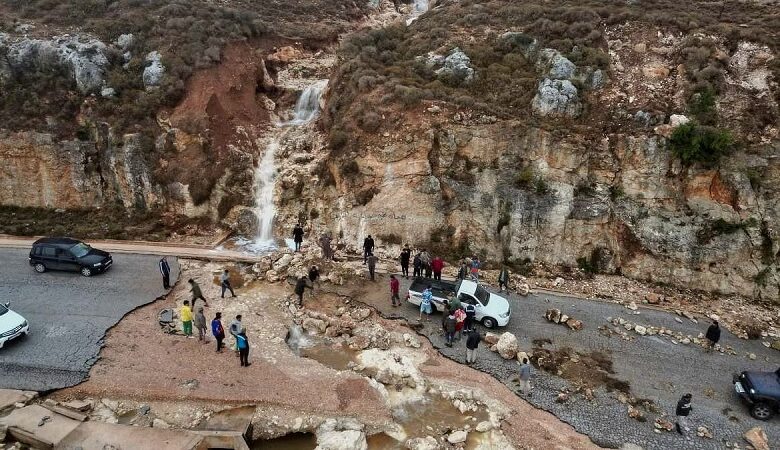Tragedy Strikes Libya as Floodwaters Unearth Over 1,500 Bodies in Derna

Emergency responders in Libya unearthed more than 1,500 bodies amidst the wreckage of the eastern city of Derna on September 12th. Tragically, the death toll is expected to rise further, with reports of approximately 10,000 individuals still missing after a catastrophic deluge unleashed havoc, obliterating entire neighbourhoods in the city.
The death toll in Derna alone has surpassed 5,300, according to Mohammed Abu-Lamousha, a spokesperson for the eastern Libya interior ministry, as reported by the state-run news agency. Derna’s ambulance authority had initially estimated the toll at 2,300.
This devastating loss of life and widespread destruction, brought about by Mediterranean storm Daniel, underscores the storm’s unparalleled intensity and highlights the vulnerabilities of a nation that has endured more than a decade of chaos. Libya’s persistent state of turmoil has resulted in a fractured nation with rival governments—one in the east and another in the west—leading to neglect of critical infrastructure in numerous regions.
Outside assistance began trickling into Derna only on September 12th, more than 36 hours after the catastrophe struck. The floodwaters inflicted substantial damage to the access roads leading to the coastal city, home to approximately 89,000 residents. Shocking images and videos depicted numerous bodies covered by blankets in hospital yards and mass graves overflowing with the deceased. To date, more than 1,500 bodies have been recovered, with nearly half of them already laid to rest as of 12th September evening, confirmed the health minister for eastern Libya.
However, the grim reality is that the death toll is expected to be significantly higher, potentially in the thousands, as Tamer Ramadan, Libya’s envoy for the International Federation of Red Cross and Red Crescent Societies, indicated. Ramadan revealed during a U.N. briefing in Geneva, conducted via videoconference from Tunisia, that more than 10,000 people were still unaccounted for. Furthermore, over 40,000 individuals have been displaced as a result of the calamity.
The catastrophe unfolded in Derna and other parts of eastern Libya on the night of 10th September. As the storm relentlessly pounded the coastline, Derna residents reported hearing loud explosions, eventually realizing that dams located outside the city had given way. The unleashed flash floods surged through Wadi Derna, a river flowing from the mountains through the heart of the city and into the sea.
One Derna resident, Ahmed Abdalla, recounted that the wall of water “erased everything in its way.” Videos shared online by locals revealed extensive swaths of mud and debris where the raging waters had swept away entire neighbourhoods on both sides of the river. Multi-story apartment buildings that had previously stood a safe distance from the river were now stripped of their facades, with concrete floors collapsing. The floodwaters left cars stranded and piled on top of one another.
Notably, Libya’s National Meteorological Center reported that it had issued early warnings for Storm Daniel, characterized as an “extreme weather event,” a full 72 hours prior to its occurrence. The center claimed to have notified all government authorities via emails and media outlets, urgently advising them to take preventive measures. Bayda, a town near Derna, recorded an unprecedented 414.1 millimetres (16.3 inches) of rainfall from 10th to 11th September.
On 12th September, local emergency responders, including troops, government personnel, volunteers, and residents, tirelessly searched through the rubble in pursuit of the deceased. They also utilized inflatable boats to recover bodies from the water. Unfortunately, many bodies were believed to be trapped beneath the debris or had been swept into the Mediterranean Sea, according to eastern Libya’s health minister, Othman Abduljaleel.Abduljaleel lamented, “We were stunned by the amount of destruction … the tragedy is very significant, and beyond the capacity of Derna and the government.”
Floods during the rainy season are not uncommon in Libya, but rarely do they result in such widespread devastation. A critical question that demands answers is how the torrential rains managed to breach two dams located outside Derna—whether it was due to inadequate maintenance or simply the sheer volume of rainfall.
Karsten Haustein, a climate scientist and meteorologist at Leipzig University, suggested that Daniel unleashed 440 millimetres (15.7 inches) of rain on eastern Libya within a short timeframe. Haustein explained that the region’s infrastructure was likely ill-equipped to handle such a deluge, leading to the dam’s collapse. He also noted that human-induced increases in water surface temperatures may have contributed to the storm’s intensity.
Derna has been neglected by local authorities for years, suffering from a lack of essential maintenance and overdue infrastructure upgrades. Jalel Harchaoui, an associate fellow specializing in Libya at the London-based Royal United Services Institute for Defense and Security Studies, emphasized the persistent delays in addressing these pressing needs. Factionalism within the country has also played a role, with Derna having been controlled by Islamic militant groups for several years. The city was only captured by military commander Khalifa Hifter, the strongman of the eastern Libya government, in 2019 after months of gruelling urban combat.
Hifter’s eastern government has harboured suspicions regarding Derna ever since its capture, seeking to sideline its residents from participating in decision-making processes, according to Harchaoui. He cautioned that this mistrust could have calamitous consequences during the post-disaster period.
The rivalry between Hifter’s eastern government, based in Benghazi, and the western government, headquartered in Tripoli, has further exacerbated the situation. Each faction enjoys support from powerful militias and foreign powers, with Hifter backed by Egypt, Russia, Jordan, and the United Arab Emirates, while the western Libya administration receives support from Turkey, Qatar, and Italy.
Despite the ongoing political divide, the initial response to the disaster has seen some cooperation between the rival governments. The western Libyan government dispatched a plane laden with 14 tons of medical supplies and healthcare personnel to Benghazi and earmarked the equivalent of $412 million for reconstruction efforts in Derna and other eastern towns. Additional humanitarian aid and rescue teams arrived in Benghazi via airplanes from Egypt, Turkey, and the United Arab Emirates. Egypt’s military chief of staff met with Hifter to coordinate relief efforts. Germany, France, and Italy also announced their intentions to dispatch rescue teams and humanitarian aid.
The logistical challenge now lies in swiftly delivering the much-needed aid to Derna, situated 250 kilometers (150 miles) east of Benghazi, given the challenging conditions on the ground. Ahmed Amdourd, a Derna municipal official, called for the establishment of a sea corridor to facilitate the delivery of aid and equipment.
U.S. President Joe Biden expressed condolences and pledged support, stating, “Jill and I send our deepest condolences to all the families who have lost loved ones in the devastating floods in Libya.”
The storm’s impact extended beyond Derna, affecting other areas in eastern Libya, including the town of Bayda, where approximately 50 fatalities were reported. The Medical Center of Bayda, the primary hospital, succumbed to flooding, necessitating the evacuation of patients, as documented in footage shared by the center on Facebook.
News Mania Desk / Agnibeena Ghosh 13th September 2023






